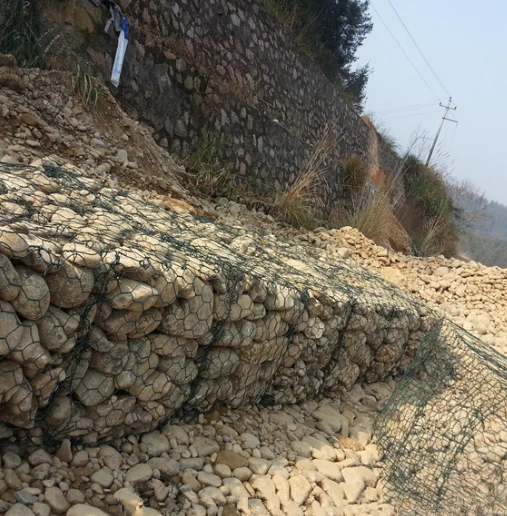2 月 . 14, 2025 00:43 Back to list
gabion weir
Gabion weirs are innovative structures that combine functionality, sustainability, and aesthetic appeal in controlling water flow and erosion in various environments. Constructed using wire mesh containers filled with rocks, these weirs serve as a crucial tool in civil engineering and environmental management.
From a maintenance perspective, gabion weirs offer significant advantages. They are designed to be flexible and can adjust to changes in the foundation or waterway without losing integrity. This flexibility minimizes long-term maintenance costs and efforts, as the structures can settle naturally without the need for immediate repairs. Moreover, the materials used in gabions, particularly galvanized or PVC-coated wires, are resistant to corrosion, ensuring longevity even in harsh environmental conditions. To ensure the success of a gabion weir project, certain considerations must be taken into account. The design should accommodate the specific hydraulic and hydrological conditions of the site. Experts recommend comprehensive site assessments to understand the soil composition, water flow patterns, and potential environmental impact. These assessments help in tailoring the gabion weir to meet the specific needs of the location, maximizing its efficiency and sustainability. Collaboration with local authorities and communities is also crucial. This collaboration not only facilitates the acquisition of necessary permits and compliance with environmental regulations but also fosters community support. Projects that involve citizen participation tend to achieve better outcomes, as they raise awareness of environmental issues and encourage local stewardship of natural resources. In conclusion, gabion weirs represent a forward-thinking approach to water management and environmental protection. Their design leverages natural materials and innovative engineering to provide an effective, sustainable, and aesthetically pleasing solution to controlling water flow and preventing erosion. For engineers, environmentalists, and policy makers, gabion weirs offer a compelling case for combining traditional knowledge with modern technology—a testament to the potential of constructing harmony between human activity and nature. As climate challenges and environmental concerns mount, the demand for such versatile, effective structures is only expected to grow, positioning gabion weirs as a cornerstone of future infrastructure development.


From a maintenance perspective, gabion weirs offer significant advantages. They are designed to be flexible and can adjust to changes in the foundation or waterway without losing integrity. This flexibility minimizes long-term maintenance costs and efforts, as the structures can settle naturally without the need for immediate repairs. Moreover, the materials used in gabions, particularly galvanized or PVC-coated wires, are resistant to corrosion, ensuring longevity even in harsh environmental conditions. To ensure the success of a gabion weir project, certain considerations must be taken into account. The design should accommodate the specific hydraulic and hydrological conditions of the site. Experts recommend comprehensive site assessments to understand the soil composition, water flow patterns, and potential environmental impact. These assessments help in tailoring the gabion weir to meet the specific needs of the location, maximizing its efficiency and sustainability. Collaboration with local authorities and communities is also crucial. This collaboration not only facilitates the acquisition of necessary permits and compliance with environmental regulations but also fosters community support. Projects that involve citizen participation tend to achieve better outcomes, as they raise awareness of environmental issues and encourage local stewardship of natural resources. In conclusion, gabion weirs represent a forward-thinking approach to water management and environmental protection. Their design leverages natural materials and innovative engineering to provide an effective, sustainable, and aesthetically pleasing solution to controlling water flow and preventing erosion. For engineers, environmentalists, and policy makers, gabion weirs offer a compelling case for combining traditional knowledge with modern technology—a testament to the potential of constructing harmony between human activity and nature. As climate challenges and environmental concerns mount, the demand for such versatile, effective structures is only expected to grow, positioning gabion weirs as a cornerstone of future infrastructure development.
Next:
Latest news
-
Wire Mesh Thickness Impact on Gabion Wall Load Bearing
NewsAug.12,2025
-
Ultimate Guide to Hexagonal Gabion Box
NewsAug.12,2025
-
Types of Rocks for Gabion Baskets Durability and Aesthetics
NewsAug.12,2025
-
Standard Gabion Box Sizes and Their Industrial Applications
NewsAug.12,2025
-
Easy Guide to Building Garden Gabion Cages at Home
NewsAug.12,2025
-
Drainage Solutions for Gabion Mesh Structures
NewsAug.12,2025
-
Visualizing Gabion 3D Integration in Urban Landscapes with Rendering
NewsJul.23,2025
Manufacturer of Silk Screen Products
QuanhuaProvide high-quality products and services to global customers.






